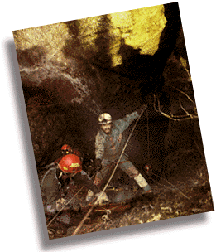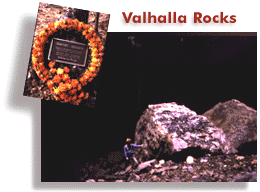
"Adventure is when you screw up and your neck is on the line and you’ve got to get your ass outta there."--Yvon Chouinard in Outside, January 1997
The sun was shining. The sky was a hazy blue. It was one of those glorious spring days in Tennessee when the breeze washes over tiny green buds on the trees and new growth begins to sprout among fallen leaves. Atilla Szedmohradszky, a 26 year old Hungarian, spent most of that beautiful day asleep inside a car after driving all night from Pennsylvania. I can only guess whether Atilla watched the sun rise on that morning of March 17, 1995, whether he had any appreciation or memory of the blue sky or the flowers that seemed to be blooming everywhere. I know only that when Atilla died not far inside a cave called Real Well a few hours later that he was wet and miserable and hanging in darkness.

Somehow in the twenty odd years I've spent exploring caves, the sense of adventure has faded. I've grown fond of lecturing that we as explorers have perfected our equipment and techniques to the point that most caves are technically quite easy, that the only challenge left is seeing how much discomfort we care to endure. Even the long vertical drops into darkness, the hallmark of southeastern caving, have become routine; we have become so accustomed to heights that dangling hundreds of feet in the air can feel as natural as sitting down to dinner.
Real Well was one of those difficult caves that modern techniques had rendered easy. For an experienced caver with the right equipment, exploration would be almost trivial. Although listed as one 90 foot pit, the entrance drop is really two distinct shafts interrupted by a large ledge and alcove. A good caver could be up those pitches and on the surface in five or ten minutes without breaking a sweat.
The sun was just setting as Atilla and his friend Andy Fust left their car and set off towards the mountainside containing Real Well. Andy was a slender, bearded young man. He had been taken to the cave the previous October during the TAG Cave-in, a huge gathering hosted by Atlanta cavers who are justly proud of the caves in the southeast and throw out an invitation to cavers across the country to come down and see why. There are those who say that high-profile events like the Cave-In, which until recently distributed directions to local caves to all participants, has been the direct cause of a number of rescues and ugly incidents. (Cavers are generally, despite the guidebooks, a secretive bunch.) An equal number call that idea xenophobic hogwash, saying that the best way to protect caves is to educate people to care about them. In any case, it does seem that at least some of those who flock to the Cave-In, like Andy Fust, learn just enough about the area's caves to get themselves in trouble later.
Whatever's Andy's level of skill, Atilla Szedmohradszky was even less experienced. Three years before he had left his small village in Hungary and come to America, where he worked as a painter. He hoped to become a citizen, and had hired a lawyer to fight deportation. Andy Fust had introduced him to caving. Together they had visited about a dozen caves.
It was nearly dark as the two young men rigged a dynamic climbing rope at the gaping sinkhole entrance to Real Well. The rope ran down a steep slope for fifty feet to the brink of the first pit, where a waterfall flowing down the left side of the sinkhole wall bathed the area in spray.
Andy and Atilla descended the first drop, which was damp from the waterfall but not particularly wet, still in the twilight zone. To this point they had managed to avoid the water. Andy actually had a wet suit available but had judged that it wouldn’t be needed. His previous visit had been during the dry season, when the water was just a trickle. Now, just below the jumble of boulders which formed the mouth of the second pit, another stream joined the first to produce a thundering waterfall. Had there been a more experienced caver with them--and in the reclusive sport of caving, where techniques are passed on by more often by a sort of apprenticeship than any kind of formal process, it's always good to have a mentor along--they might have turned back for lack of wetsuits. But Andy and Atilla continued, rappelling into the torrent.
We tend to forget that people die caving. It's rare, but it happens. One harmless summer day in 1985, two rocks, each the size of a school bus, quietly
 peeled off a wall at the bottom of a deep shaft called Valhalla and buried two young cavers. It wasn't anyone’s fault; they simply had the misfortune to be at the wrong place at the wrong time. Yet such accidents are rare, statistically improbable. When people die in a cave, it's generally because they made at least one very obvious mistake.
peeled off a wall at the bottom of a deep shaft called Valhalla and buried two young cavers. It wasn't anyone’s fault; they simply had the misfortune to be at the wrong place at the wrong time. Yet such accidents are rare, statistically improbable. When people die in a cave, it's generally because they made at least one very obvious mistake.
On television everyone can be a hero, the rescuers for their skill and courage, the victim for simply having the grit to survive the ordeal. But privately, those of us involved in rescue rarely fail to place blame where we think it belongs. It's too easy to judge when you're the rescuer, smug with both expertise and hindsight. Members of one high-angle rescue team, having saved the life of more than a couple drunks splattered at the bottom of cliffs, go so far as to wear a t-shirt that proclaims, "We interfere with natural selection."
There in Real Well, Atilla may not have known the exact number of people who had died of hypothermia trying to climb wet drops without the proper equipment or training--for dying that way is an old trick--but he must have sensed that he was in trouble. While Andy was eager to explore more of the cave, Atilla was cold and anxious. He told his friend that he was starting out.
Atilla was wearing blue jeans, work boots, and a T-shirt with a green insulated windbreaker over it. Once wet, for all the protection his clothing provided, he might as well have been naked. Around his neck, in a pitiful attempt to keep the water out, was a bandanna. His head was bare except for a Petzl Zoom light secured with elastic straps, barely adequate for dry caves and no match for a waterfall. His climbing system consisted of a prusik sling to one foot, and a Petzl "Jammer" ascender tied off to his seat. Around his chest was a crude harness of rope connected by a mass of carabiners into his top ascender sling. He clipped into the rope and began climbing, swinging back and forth in the water.
Some say that Hell is a hot place, but long-time cavers might argue otherwise. Hell is water like that running against your bare skin, pure ice, sucking the warmth out of you. Immediately the body reacts, constricting blood vessels, cutting off the flow to the extremities to protect the core. In a few minutes fingers and hands are numb, useless. The body begins to shut down non-essential functions, including the powers of reason. Sailors have what is called the "Fifty Rule": in 50 degree water, 50 percent of people will be dead in 50 minutes.
Atilla had been on rope for about half an hour--too long already under those conditions--before Andy realized he was in trouble. Later rescuers would theorize that one of the nonlocking carabiners between Atilla’s upper ascender and seat harness opened, dropping him two or three feet and leaving that crucial ascender out of his reach. Most cavers would have simply pulled out a backup ascender, but Atilla had no such device; he could do nothing but hang in the freezing water. By the time Andy got on rope and climbed up beneath him, it was almost too late. Atilla could answer his questions, but couldn't move his arms.
Andy climbed past him on the rope, clipping a sling to him, and attempted to lift Atilla the final few feet to the ledge. Either he or his climbing system were inadequate for the task. Instead, he found himself shivering, weak from the cold, and trapped on the rope with Atilla's weight below him. If not for the configuration of the top of the pit, both men might have died there. Somehow Andy was able to get off the rope and freeclimb the last few feet to safety. Below him, Atilla hung in darkness.
What happened next remains somewhat unexplained. It was still relatively early in the evening. If Andy had climbed the rest of the way out of the cave and gone for help immediately, there might have been some slim hope for Atilla's survival. But Andy didn't immediately go for help.
Andy had abandoned at least some of his ascending gear on the rope in making his own escape. This he managed to retrieve. He later said that he tried at least once more to get Atilla up the rope, only to be beaten back by the cold. "Every time I got near the rope," he told the Chattanooga Times, "I was in the water, and it was so cold I was shaking in 30 seconds." In the midst of all this--and here the account gets strange enough that it was initially thought there might be some language barrier--Andy reportedly said that he "went to sleep" for several hours on the ledge while his friend hung just below on the rope.
It was nearly daybreak before Andy went for help. When it arrived Sunday morning, it was far too late for Atilla. In fairness, the delay probably would not have made much difference. Rescuers, supported by a host of local agencies and volunteers, quickly moved into the cave. Atilla was arched back on the rope, his upper body nearly horizontal. His open mouth and nostrils were full of water. His upper ascender was two feet from the top of the second drop; his body was another five feet below. When he was found, Atilla was a mere seven feet from the safety of the ledge.
By the time I rappel the entrance drop into Real Well, it is late on Sunday afternoon. Atilla has been hoisted up to the ledge and lowered onto the top of a large rock where his body is now sprawled, still visibly bowed from the long hours in the water, his blonde head thrown back. His hands are bone white, clutching the air near his chest. A couple of days ago he'd gotten into a car and come south looking for adventure and unfortunately he'd found it.
We examine Atilla’s equipment like the cynical critics we are. What, he had no helmet? Is that his climbing system? Nearly everything we see offers damning testimony: the dynamic rope rigged in the pit, completely unsuited to caving; a pack full of apples that would never survive the bruising afforded by a typical cave; Atilla's lack of a helmet, a proper light, or a viable climbing system.
Most damning of all is the fact that Fust, at least, should have known better. It's rude and perhaps wrong to make that statement, but then, perhaps that was part of what led to the disaster in the first place. Andy Fust was said to have several years of caving experience. He had hung around with organized cavers in Pennsylvania, practiced vertical techniques and rescue techniques with them in trees. And yet he led his friend Atilla to a wet vertical cave with dynamic rope, nonlocking carabiners, and a pack full of apples. Somehow, organized caving had failed him, taught him enough to get himself in trouble but not how to get out of it. As we photograph the body, I’m not sure which of the two men I pity more: the life which lies extinguished in front of us or the haunted young man with the beard who is waiting somewhere outside.
We unclip Atilla from the rope and maneuver the body into the heavy black bag. The zipper closes over his face and we begin strapping the bag into the litter with one inch webbing. The mild exertion makes the back of my neck run with sweat. I have capilene against my skin, then thick neoprene under nylon coveralls. My hands are insulated by latex gloves with another pair of leather on top. I pull off the layers of gloves, then scramble across the room to the waterfall a few feet above the shadowed place where Atilla died.
What happened here shouldn't have happened, I think. At a time when techniques make 500 foot pits routine, the days of dying on a rope in a 40 foot waterfall should be long over. I look into the spray and imagine how the dim glow from above would have slowly faded as night came upon the mountain. How long did Andy stand in this spot, staring downward, the dark walls all around him, the water roaring past, so constant and uncaring? There is more to this story, I'm sure, than the obvious conclusions, the quick but private condemnations and T-shirts making wisecracks about natural selection. Somewhere in the murky distance between the Act of God that crushed those two souls in Valhalla and the typical drunk at the bottom of the cliff is a story of two friends who came to a cave called Real Well, who might have known better, but didn't.
In a few minutes they'll be hoisting Atilla's body into the late afternoon sunshine of another beautiful Spring day. Inside my wetsuit it's still uncomfortably warm, and I yank the zipper down my chest. I step forward and stand for long moments as the chilled water flows against my skin.
Epilogue: Andrew Fust did not quit caving after the tragedy at Real Well. To his credit, he later enrolled in a rescue training class with the National Cave Rescue Commission. At least one of those who got to know him during the training said later that he seemed like a nice fellow.
Photographs:
Title: No caver is immune to carelessless. The author's foot loop was sawed in half by weld abrasion and failed 150 feet off the floor in Valhalla.
Next: Rescuers lift Atilla up the slope to the surface.
Next: The rocks which crushed two cavers at the bottom of Valhalla's entrance shaft now look like they've been there forever. The memorial is at the top of the pit.
Water |
Caving |
Hang Gliding |
Backpacking |
About
![]()

Copyright © 1996-2013 by Rodger Ling.
All rights reserved.





